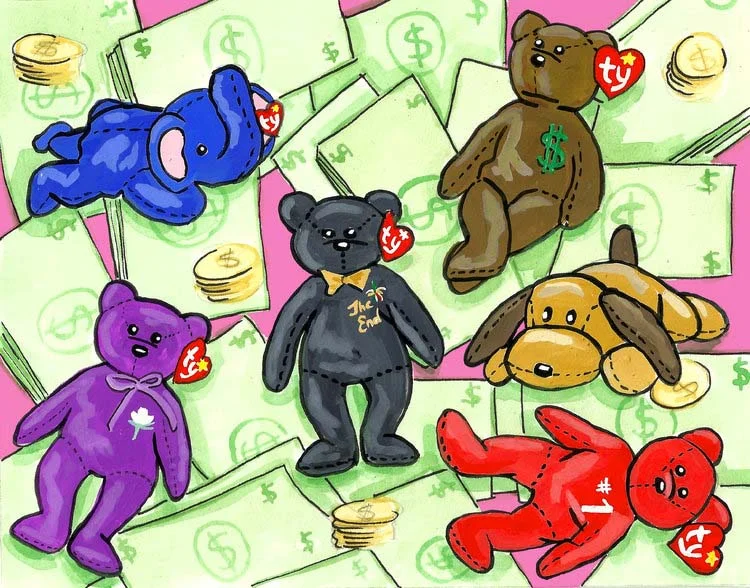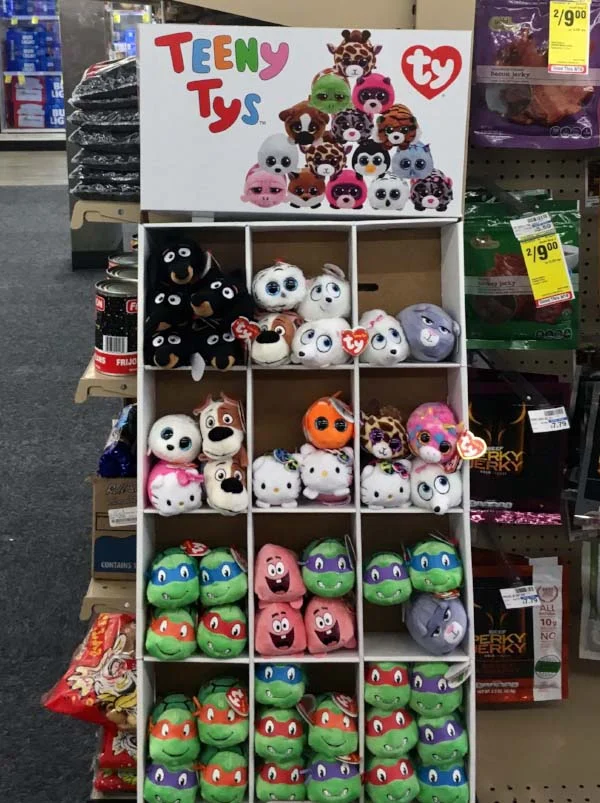What To Do With All The Beanie Babies You Have in Storage
How to profit from childhood memories.
By Jessie Schiewe
There's still (some) money to be made in selling collectable Beanie Babies, but there's a lot you have to know — and do — to get it. (Art: Brenna Daugherty)
It’s been 25 years since Ty Warner released the first Beanie Baby in 1993, but chances are you probably still have a few of the collectable toys in storage.
In fact, if you were a kid during the ‘90s, you probably have tons — and you probably haven’t looked at them or thought about them in years.
Meanwhile, Ty Inc. hasn’t gone anywhere. The Illinois toy manufacturer still sells Beanies, and has a number of other lines, too, including Beanie Buddies, Beanie Boos, and Beanie Ballz. Over the years, it has made adventurous tweaks and additions to its toys to keep customers interested in them.
In the mid-2000s, they tried selling a spin-off line called Beanie Babies 2.0 where each toy came with a secret code to a kid-centric website filled with games, chat rooms, and art projects. They gave a short-lived line called the Monstaz embroidered hearts that, when pushed, made sound, and since 2017, have been selling Mini Boos, small, hand-painted figurines made out of plastic, velvet, or what one Beanie blogger called “some type of hard rubber.”
But because Beanies are now so common — you can even find them at CVS — their worth has lessened and they’re hardly as coveted as they were during their peak 20 years ago.
Ty is now one of the most ubiquitous toy manufacturers in the U.S. You can even find them at your neighborhood CVS store. (Photo: Jessie Schiewe)
As a longtime collector named Dennis (whose name has been changed for this article) told OK Whatever:
“The ‘90s and 2000s were like the prime time to sell Beanie Babies. They were going for thousands and thousands of dollars back then.”
The most coveted ones, he said, could fetch between $2,000 to $4,000 each.
While they’ve diminished in value — a Beanie Baby worth $900 in 2001 might be worth $300 now — they can still fetch a pretty penny in today’s market, especially if they are prototypes, Employee Bears, limited releases, first generations, “crazy oddities,” or ones signed by Warner himself.
In the 2000s, Warner maximized the rarity and thus worth of his Beanies by only manufacturing 300 versions of particular plushies, like the Billionaire Bear.
In recent years, Dennis has noticed a spike in the number of high-value Beanies being listed on the market or auctioned off online.
He thinks it’s because collectors, namely “executives” who’ve received special Beanies, are dying and their family members are selling or donating their belongings. Bidding results are usually the result when this happens, as high-end collectors vie to snap up the rare and seldom seen Beanies.
Dennis believes that if you’ve got a bag of them laying around, now might be the time to sell them before they lose any more value.
“It might be best for people to sell them now instead of hold on to them,” he said. “I think things are kind of where they’re going to be. I don’t see their value increasing in the future, especially for the more common ones that are 99 percent of what’s out there.”
Dennis recently sold a Princess Diana Bear that was missing the heart emblem on its chest due to a manufacturing error. He got $700 for it. (Art: Case Jernigan)
Just make sure you have realistic expectations if you do try to sell yours. There are tons of articles out there baiting readers with headlines like “If You Have Any of These 11 Beanie Babies, You Can Retire Now” that are more than a little misleading.
“There’s so much fake information out there and articles claiming these things are worth thousands upon thousands of dollars. And it’s just not true,” Dennis said.
But Beanie Babies still have some worth, especially within collector communities, so who knows? You might have a rare gem tucked away in your closet. If you want to find out, here are Dennis’ tips on how to turn your Beanie stash into a pile of cash.
Make sure your Beanies aren’t fakes
Fake Beanie Babies started being manufactured in the mid-90s right when the toys were becoming popular, and the bulk of knock-offs that exist are of older models. Fortunately, it’s easy to recognize a counterfeit Beanie from their handmade brethren.
“One way to tell a fake one is the fabric,” Dennis said. “It might be a slightly different color, slightly different sheen or shininess, or have a slightly longer pile than it is supposed to. Also, things like the little plastic eyes will be a different shape or size.”
He recommends comparing it to a certifiably real Beanie to better spot the differences.
Figure out what generations you have
A Beanie Baby’s tag will tell you what generation it is from — how old it is, how valuable it is — which will dictate its worth. Dennis recommended searching online for examples of various tag generations and then comparing them to the ones you have. Divide your Beanie Babies up into piles of different generations to make sure you don’t mix them up.
Find out their worth
Once you’ve figured out what generations your Beanie Babies are from, take photos of the piles you’ve created for each generation. Posting these photos online in Beanie Baby Facebook groups is a good place to start.
“People will very quickly respond to posts on these groups and tell you how much each one is worth. And every once in awhile, they’ll try to buy one off you.”
Make sure you’re getting the right bang for your buck
To double-check how much a Beanie Baby is worth, you can either contact a Beanie Baby appraiser directly or check out the sold listings on eBay.
“I always tell people you can’t go by asking prices on eBay because I could put a dirty sock on eBay for $1 million and that doesn’t mean it’s worth that,” Dennis said. “So go to sold listings and sort from lowest price first. And if you look at the first five to 10 listings and find their average, that’s generally your ballpark value.”
Sell them!
Facebook and eBay are the main ways to sell your Beanie Babies once you understand their worth. For particularly valuable or rare Beanie Babies, you can send them to a professional authentication business — like Peggy Gallagher Enterprises — that will put your Beanie in a sealed, acrylic display case and supply a certificate of authenticity. Though it might seem like an extra step, Dennis recommended doing this for really special ones if you want to get top dollar for them.
And, if you’ve got some really rare Beanie Babies, don’t be surprised if you get contacted by the “private sale community.”
“Those people are high-end collectors, mostly men, that don’t want to pay the eBay fees for exchanging things,” Dennis said. “Or they don’t want certain Beanie Babies to be seen by the public because they’re that coveted.”
Still, before making any sales, make sure you check in with a legitimate appraiser, so you don’t get ripped off.
“There are high-end collectors that really understand values,” he said. “But then there are also chap resellers that will offer you way under retail so they can resell it for much more.”








How to profit from childhood memories.